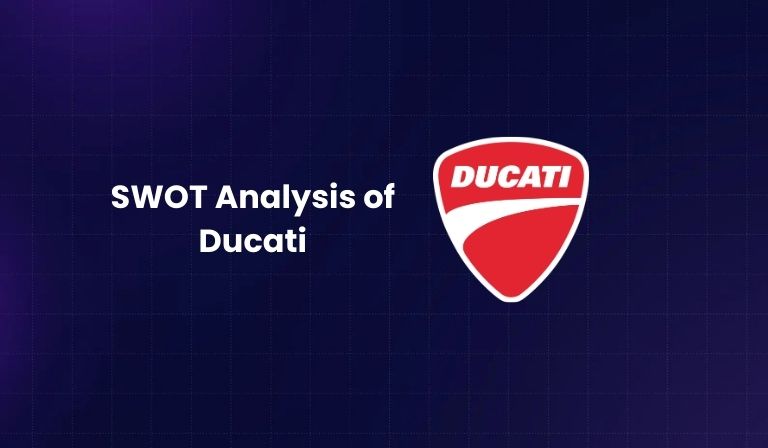Summary
Ducati, the iconic Italian motorcycle brand, is globally recognized for its premium superbikes, cutting-edge technology, and racing pedigree. In this comprehensive guide, we explore the SWOT Analysis of Ducati in 2025. This includes its strengths such as racing dominance and distinctive engineering, weaknesses like high costs and dependence on a complex partner network, opportunities in emerging markets and smart mobility, and threats such as intense competition and substitutes like luxury cars. Whether you’re a motorcycle enthusiast, business analyst, or investor, this SWOT analysis provides an in-depth understanding of Ducati’s market position, challenges, and future potential.
Ducati is not just a motorcycle manufacturer; it is a global lifestyle brand representing speed, innovation, and Italian craftsmanship. Founded in Bologna, Italy, and currently owned by Lamborghini (under the Volkswagen Group), Ducati has become synonymous with high-performance superbikes.
The brand has achieved worldwide recognition thanks to its engineering marvels like the Desmodromic valve control system, Trellis frame, and L-Twin engines. Ducati is also a market leader in racing, with multiple MotoGP and World Superbike Championship titles to its name.
Some of its flagship models include:
- Diavel – known for power and aggressive design.
- Monster – an urban naked bike icon.
- Multistrada – a versatile touring machine.
- SuperSport and Superbikes – combining track performance with road usability.
In this blog, we break down the SWOT Analysis of Ducati to understand how the brand leverages its strengths, addresses weaknesses, capitalizes on opportunities, and navigates threats in the competitive motorcycle industry.
Strengths of Ducati
1. Distinguishing Features
Ducati motorcycles are not just vehicles; they are a piece of art combined with engineering excellence. Features like the Desmodromic valve control system, steel Trellis frame, and signature L-Twin engines set Ducati apart from competitors like Yamaha, Honda, and Kawasaki.
The distinctive exhaust sound and sharp Italian styling add to its unique appeal. These differentiating features have created a strong emotional connection with riders, making Ducati bikes not just a mode of transport but an aspirational lifestyle purchase.
2. Racing Victories
Ducati’s DNA is deeply tied to motorsports. The brand has won numerous titles:
- 15 of the last 18 Riders’ titles.
- 16 Manufacturers’ titles in World Superbike.
- Strong performance in MotoGP championships.
These victories reinforce Ducati’s image as a performance-driven motorcycle brand. Racing success also translates into commercial sales, as technology from track bikes is often integrated into production models, giving Ducati an edge in innovation.
3. Market Leadership
Ducati enjoys leadership in key motorcycle markets such as USA, Italy, Spain, and Germany. Despite economic slowdowns, Ducati’s sales have grown at an average of 8% annually (2015–2016 data as a benchmark).
Its strong positioning in developed markets gives it a premium brand image, making it one of the most desired superbike brands worldwide.
4. Desmo Owners Club (DOC)
One of Ducati’s most powerful brand assets is its Desmo Owners Club, a global community of Ducati enthusiasts. These passionate bikers regularly organize rides, events, and Ducati-exclusive meetups.
This not only builds customer loyalty but also acts as a free marketing channel, as DOC members actively promote the brand within biking communities. Such high engagement makes Ducati more than a motorcycle—it becomes part of a rider’s identity.
Weaknesses of Ducati
1. Extensive Partner Network
Ducati relies on a large global network of partners, suppliers, and after-sales service centers. Managing this complex network is a challenge, and often leads to issues with quality consistency and service delivery across geographies. Unlike Japanese manufacturers who have tighter supply control, Ducati struggles with operational efficiency.
2. High Cost of Spares and Raw Materials
Premium engineering comes at a price. Ducati bikes use specialized materials and advanced technology, which increases costs. Spare parts are not easily available worldwide, leading to service delays and higher ownership costs.
This makes Ducati less attractive in price-sensitive markets like India and Southeast Asia, where maintenance costs influence purchase decisions.
3. Product Overhauling Expenses
Ducati’s strategy to revamp several models, including a complete overhaul of the Multistrada, demanded heavy investment in R&D and production. While innovation is crucial, the returns on such large-scale revamps are uncertain, adding financial pressure to the company.
Opportunities for Ducati
1. Growing Demand for Driving Safety
As road safety becomes a global concern, riders are shifting from low-powered commuter bikes to high-performance superbikes that offer better handling, braking, and safety features. Ducati can leverage this trend by emphasizing the safety and stability of its motorcycles in its branding.
2. Emerging Market Expansion
Traditionally, Ducati’s customer base has been in Europe and North America. But today, emerging markets like India, Brazil, and Southeast Asia have a growing segment of wealthy biking enthusiasts willing to invest in premium superbikes.
By expanding dealerships and local manufacturing, Ducati can tap into these lucrative growth opportunities.
3. Technological Advancements
The future of mobility lies in smart, connected, and sustainable vehicles. Ducati can explore:
- IoT-enabled bikes with real-time monitoring.
- Autonomous assistance systems for safer riding.
- Electric superbikes to meet the rising demand for eco-friendly transport.
If Ducati innovates quickly, it can dominate the next generation of motorcycles.
Threats to Ducati
1. Intense Competition
Ducati competes with industry giants like Harley Davidson, Yamaha, Suzuki, Honda, and Kawasaki. These brands have stronger global distribution, lower pricing strategies, and larger R&D budgets.
If Ducati fails to keep innovating, it risks losing its premium market share to rivals offering more value-for-money products.
2. Threat of Substitutes
High-performance superbikes like Ducati often cost as much as, or even more than, luxury cars. For many consumers, the choice between a superbike and a car leans towards the latter due to safety, practicality, and family needs.
This substitution risk is significant, especially in markets where road infrastructure and safety standards are poor.
Conclusion
The SWOT Analysis of Ducati reveals a brand with strong foundations in innovation, racing, and premium positioning. Its strengths in distinctive engineering, racing success, and loyal customer base give it a competitive edge. However, weaknesses like high costs, complex partner networks, and expensive overhauls limit scalability.
Future opportunities lie in emerging markets, advanced technologies, and eco-friendly superbikes. Yet, Ducati must tackle threats from aggressive competitors and substitute products like luxury cars.
If Ducati leverages its legacy while embracing innovation, it can continue to lead the superbike industry and expand its dominance globally.
FAQs
What makes Ducati motorcycles unique?
Ducati bikes stand out for their Desmodromic valve system, Trellis frame, L-Twin engines, and unique design, making them a blend of engineering and art.
Is Ducati successful in racing?
Yes. Ducati has won multiple World Superbike Championships, MotoGP titles, and over 15 Riders’ titles, proving its dominance in motorsports.
What are Ducati’s biggest weaknesses?
High spare part costs, dependence on a wide partner network, and expensive product revamps are some of Ducati’s weaknesses.
What opportunities does Ducati have in 2025?
Emerging markets, rising demand for safe superbikes, and technological advancements like electric and connected motorcycles provide major opportunities.
Who are Ducati’s main competitors?
Ducati faces competition from Harley Davidson, Honda, Yamaha, Suzuki, and Kawasaki in the superbike and performance motorcycle segments.
A digital marketer with a strong focus on SEO, content creation, and AI tools. Creates helpful, easy-to-understand content that connects with readers and ranks well on search engines. Loves using smart tools to save time, improve content quality, and grow online reach.

